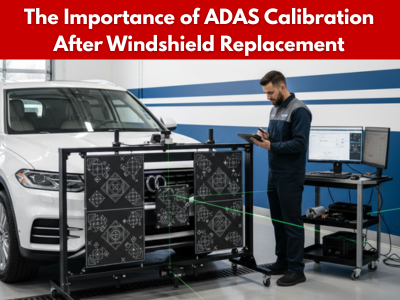At National Auto Glass, we’ve seen firsthand how vehicles have evolved. Modern cars are no longer just about getting from point A to point B; they’re sophisticated machines packed with advanced technology designed to keep us safer on the road. A key part of this evolution is the widespread adoption of Advanced Driver Assistance Systems (ADAS). These systems rely on an array of sensors and cameras, many of which are mounted directly to your windshield. This is why, when you need a windshield replacement, ADAS calibration isn’t just a recommendation; it’s a critical safety measure.
What is ADAS and why is it so important?

ADAS encompasses a wide range of features designed to assist drivers and prevent accidents. Think about features like adaptive cruise control, lane departure warning, automatic emergency braking, traffic sign recognition, and pedestrian detection. These aren’t just fancy add-ons; they actively monitor your surroundings and can intervene to help you avoid collisions or mitigate their severity.
For example, a lane departure warning system uses a camera to track lane markings. If you start to drift without signaling, it can alert you or even gently steer you back into your lane. Automatic emergency braking uses radar and cameras to detect potential frontal collisions and can apply the brakes if you don’t react in time. These systems are constantly working in the background, providing an extra layer of protection for you, your passengers, and other road users.
The critical link between your windshield and ADAS
The front-facing camera, a cornerstone of many ADAS features, is typically mounted at the top of your windshield, often behind your rearview mirror. This camera is meticulously aimed to provide an accurate view of the road ahead. Its precise positioning and angle are crucial for the ADAS system to interpret information correctly. If the camera’s perspective is even slightly off, the entire system can be compromised.
Imagine trying to read a map while holding it at an odd angle; you’d likely misinterpret directions. Similarly, if your ADAS camera isn’t properly aligned, it might misread lane markings, fail to detect a pedestrian, or react inappropriately to traffic signs. This is where the importance of professional ADAS calibration comes into play after a windshield replacement.
Why does Windshield Replacement necessitate ADAS Calibration?
When your windshield is replaced, even by the most skilled technicians, the new glass will have subtle differences in its mounting position compared to the old one. These microscopic shifts are enough to throw off the precise alignment of the ADAS camera and other sensors. It’s not a reflection of poor workmanship; it’s an inherent part of the replacement process.
Think of it like getting a new pair of glasses. Even if your prescription is the same, you might need a slight adjustment to the frame to ensure they sit perfectly on your face and provide optimal vision. Similarly, after a windshield replacement, the ADAS system needs to be “recalibrated” to its new environment. This process involves using specialized tools and software to ensure that the camera and sensors are correctly aligned with the vehicle’s computer and the road.
Without proper calibration, your ADAS features might not function as intended. This can lead to various issues:
- False warnings: The system might trigger alerts when there’s no actual danger.
- Delayed reactions: Critical safety features might not activate in time when they’re truly needed.
- System malfunctions: The ADAS system could become completely inoperative, leaving you without vital safety nets.
- Incorrect information: Traffic sign recognition might display the wrong speed limits.
- Reduced safety: Ultimately, an uncalibrated ADAS system means your vehicle is not as safe as it was designed to be.
The calibration process: Static vs. dynamic
There are generally two types of ADAS calibration:
- Static calibration: This is performed in our service bay while the vehicle is stationary. It involves using specialized targets and equipment to align the camera and sensors according to the manufacturer’s specifications.
- Dynamic calibration: This type of calibration requires driving the vehicle under specific conditions, often at certain speeds and for a set distance. The vehicle’s computer gathers data during this drive to fine-tune the sensor readings.
Many vehicles require both types, and our technicians are trained and equipped to handle both. This ensures your ADAS features are restored to factory standards.
Signs your ADAS may need recalibration
Even if your vehicle isn’t displaying a warning light, there are a few signs that your ADAS system might be misaligned:
- Your lane departure warning is activating incorrectly
- Cruise control isn’t maintaining proper distance
- The camera view appears tilted or off-center
- You had recent collision repair work or a windshield replacement
If you notice any of these, reach out to us as soon as possible. It’s better to check and be safe than to rely on a system that’s not working as intended.
Ensuring your safety with National Auto Glass
We understand how important it is for your vehicle’s safety systems to work exactly as they should. That’s why we go the extra mile with every windshield replacement in Toronto by offering full ADAS calibration services.
Whether you drive a luxury car, SUV, or a daily commuter, our technicians make sure your windshield and sensors are installed and calibrated to factory standards.
Ready to book an appointment or have questions about your vehicle’s ADAS system? Give us a call at (416) 666-7345, or fill out our free quote form now. We’re happy to walk you through the process and make sure you’re back on the road safely.
